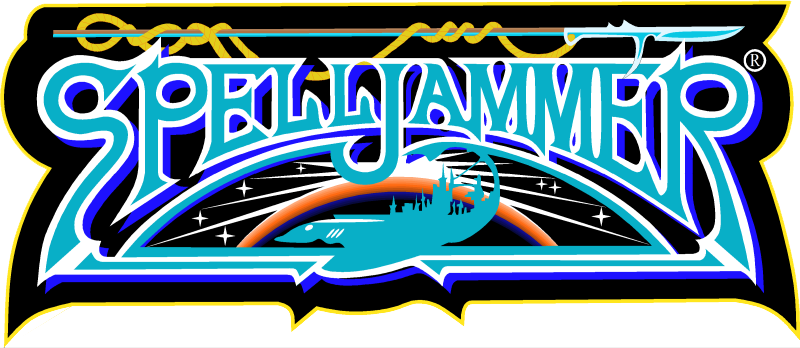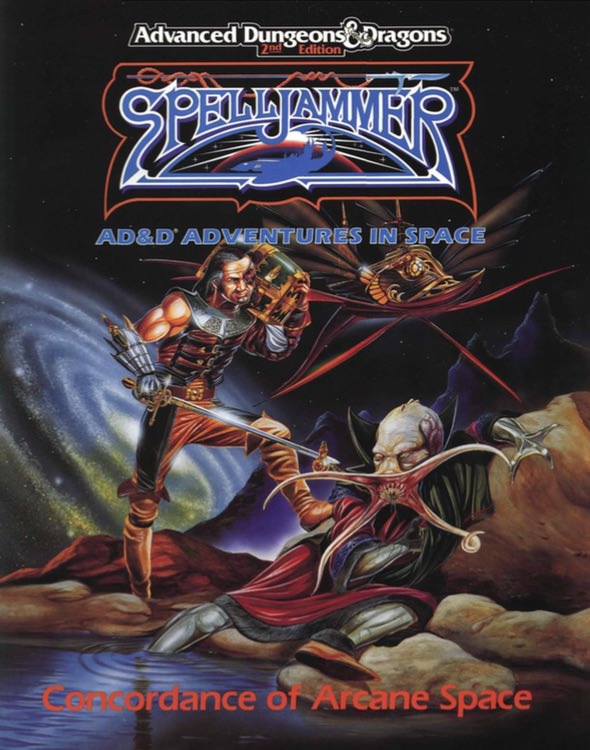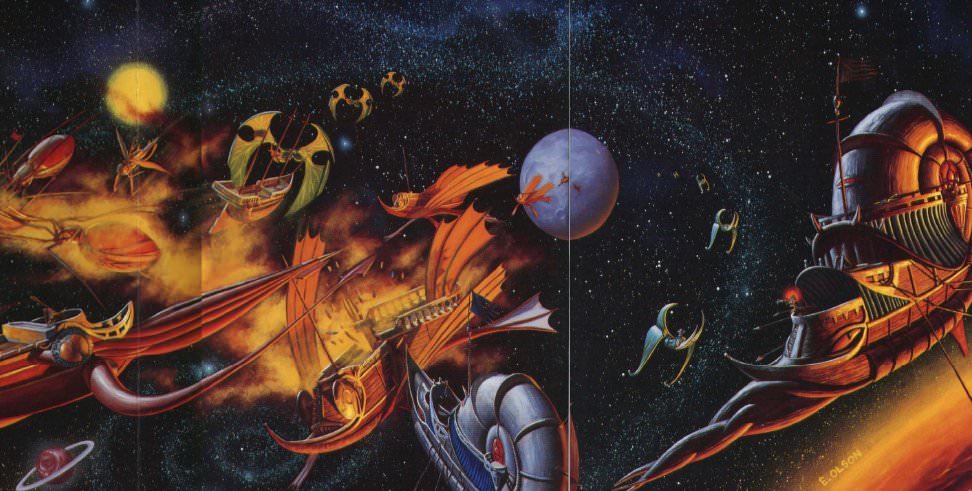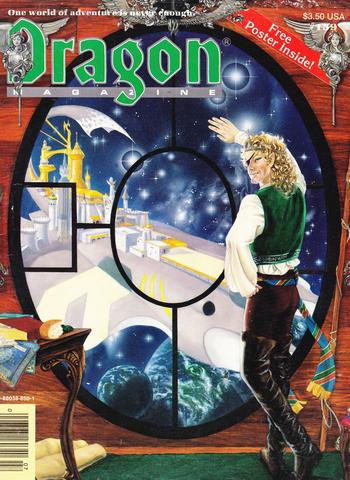Spelljammer by Valatar
I present to you the most metal D&D setting of all time
Original SA postAlien Rope Burn has forced me to do this. After having been mercilessly Starfingered for weeks now, I felt an irresistible compulsion to counteract that joyless slog with actual fun. Messy, broken, flawed fun that came out of lackluster intentions, but fun nonetheless.
I present to you the most metal D&D setting of all time:


A pirate guy with a space boat beating up another guy with an octopus for a face. Nothing about this does not deserve to be painted on the side of someone's van.
A history:
Like a lot of nerds who've caught lightning in a bottle, Gary Gygax was singularly unqualified to run a large company. He hared off after his dreams of turning Dungeons and Dragons into a media-spanning empire and basically left the company in the hands of acquaintances who, through bad luck, incompetence, embezzling, or multiples of those managed to send the company into a nosedive. He wandered back to find TSR on fire and got them ousted by the board, but apparently not in time to prevent huge losses and layoffs. They also between them had a large number of shares of company stock, which they promptly sold to Lorraine Williams, the then-general manager of the company, giving her controlling share which she used to shitcan ol' Gary. A lot of old D&D grognards make Lorraine out to be a Satan who hated nerds, sued fansites maliciously, prevented writers from playtesting product with a 'no playing games' rule at the company, and more, but a lot of those stories aren't verified and will probably never be more than rumor. What is not rumor is that her eventually-fatal plan for TSR was to spitball in every direction and see what stuck. This led to heavy investment in failed product lines that sank the company like a stone (see Spellfire and Dragon Dice, TSR's ill-advised attempts to compete with Magic) but it also caused the explosion of campaign settings in the late 80s and early 90s. One of the first of these 'let's see if it sticks' settings was Spelljammer.
On the face of it, Spelljammer is a somewhat cynical setting. It looks more than a little bit like a 'setting' that actually only exists to tie other ground-based settings together. Is your party tired of being on Krynn? Well step right up and buy our box set and they can be on their way to Toril! On his blog, Jeff Grubb mentions that this was not the primary thrust behind Spelljammer and instead something of a side-effect that they took advantage of, but Spelljammer suffered throughout its life by not having a comprehensive setting in the same way things like Forgotten Realms had. Near the end of its run TSR finally did churn out a box set with a Spelljammer-only setting, The Astromundi Cluster, but honestly it wasn't that great and didn't turn anything around. It was by and large up to a DM to make up sufficient content for their game, and I think that's what hurt it the most.
The Setting (such as it is):
Spelljammer is less of a setting than a bolt-on rule mechanic upgrade for D&D. The bulk of the main box set is spent on laying the groundwork for how space works and how ships work in space. Here is the gist of it: Space works in a way that lets you fly boats in space and have adventures. Anything that keeps you from being on a boat in space and having adventures is not how space works. Are you concerned about microgravity? Well don't be, because a 30-foot boat in space is all you need for 1G. No matter how big or small a boat you have, it's 1G. Need a space suit? Ha no space suits are for your dad. Your ten tons of wood boat have sufficient gravity to attract and hold a bubble of air around it that will keep ten people breathing for about half a year, so your barbarian can go right on wearing a furry He-Man diaper and nothing else. This is not to say that everything is completely hand-waved away; there are fun gravity tricks such that a ship's gravity is a flat plane that goes through the midpoint of the ship, so a character can be standing up on the underside of a ship in space, some ships have decks that are reverse gravity from other decks, and a couple of ships are actually designed without a 'bottom'. This can lead to some fun times when your ship enters a larger object's gravity and what had been the floor promptly turns into the ceiling, better hope your stuff was tied down. Air is more of a dramatic device than anything else; while it's difficult for a ship with a normal crew compliment to run out, certain space creatures and phenomena can spoil a ship's air supply and cause trouble.
The astronomy of D&D was set up to explain the often-contradictory existence of the ground settings. The solar systems all exist in gargantuan spheres that contain the sun(s) and planets and moons and all that, completely separate from other solar systems. Within a given crystal sphere, local rules apply: Planets orbit suns, suns orbit planets, planets are flat and on the back of a space turtle, planets are hollow and have a sun inside them, anything goes. The 'stars' visible from a world are not other suns, but are instead lights dotting the inside of the crystal sphere and can be giant torches, alien cities, portals to the plane of fire, windows to the outside, whatever.
Speaking of the outside, the thing outside of all of the crystal spheres is the phlogiston, a luminous and highly flammable vapor that flows around them. (Phlogiston is an actual pseudoscience material from ye olde days that attempted to explain combustion.) The flows act like jet streams, allowing a ship moving with the stream to achieve tremendous speed and travel from system to system in relatively short order, if one knows the way. The lack of random magic spaceships popping in on Athas, for example, was explained away by its crystal sphere being extremely remote, or the phlogiston flows around it being unfavorable to navigation.
A side effect of the whole 'local rules apply' thing is that divine spellcasters were occasionally in some trouble. The phlogiston, being unreachable by planar contact to some extent, dampened a cleric's ability to contact their deity and recover higher-level spells, and when in a crystal sphere the local gods may or may not be cool with them. Your cleric of Sithrak may be at full power upon entering an unknown sphere, or may be severely diminished. To that end a great many clerics in Spelljammer were taking up the missionary life, attempting to establish sufficient worshipers in every system they could for their god to have sway there, and there were several common pantheons in use among spacefaring clerics that had wider reach than more narrowly-focused ground-based gods. If all else failed, a cleric in a distant sphere with no faith friendly to their god could use a spell to contact their god and regain spells normally. This still managed to be far, far less obnoxious than Planescape's restriction on magic, but was still something that players had to keep in mind, as magical healing wasn't necessarily something they could rely upon.
It's late so I'm wrapping up here. Next up, Spelljamming (verb), Spelljammers (noun), and The Spelljammer (proper noun)
Spelljamming (the verb)
Original SA postDalaranJ posted:
Ugh, I’m so over talking frogs now.
One thing that’s unfortunate about spelljammer is that it sort of forces the implication that every setting takes place on a planetoid. I think that’s unfairly limiting.
This was already brushed upon, but I just want to revisit it real quick. D&D's main settings are on run-of-the-mill planetoids, Spelljammer is tethered to that whenever it deals with them. Left to its own devices, however, they have ample numbers of weird worlds. One sourcebook was made specifically detailing examples of worlds to be found out there, Practical Planetology, and in addition to normal rocky worlds, they had water worlds, fire worlds, air worlds, and then weird worlds. The weird ones consisted of Torus, a donut-shaped world, Plata, a diskworld, and the cunningly-named ringworld Nivil.
 I also recall a plant world where the entire thing was a huge overgrown vine, a dead moon where pretty much the whole surface was animated skeletons, and even though I can't find it I would swear there was a crystal sphere where its world was a flat plane filling the sphere from edge to edge with a hole in its center, with a sun that bobbed up and down through the hole to provide night and day. So yeah, DMs were pretty encouraged to just go nuts when coming up with worlds to encounter.
I also recall a plant world where the entire thing was a huge overgrown vine, a dead moon where pretty much the whole surface was animated skeletons, and even though I can't find it I would swear there was a crystal sphere where its world was a flat plane filling the sphere from edge to edge with a hole in its center, with a sun that bobbed up and down through the hole to provide night and day. So yeah, DMs were pretty encouraged to just go nuts when coming up with worlds to encounter.Anywho:

Spelljamming (the verb)
The titular activity of the setting, spelljamming (the verb) is to move around in space. The default method for doing this involves a chair-shaped magical device called a Helm. You sit your party spellcaster in it (any spellcaster will do, arcane or divine), the Helm sucks out all of their spells for the day instantaneously, and in exchange they can make the magic space boat move for twelve hours. They can push past this soft limit, but at an increasingly-diminished rate of speed. There are two flavors of Helm, major and minor, with minor Helms able to move ships up to fifty tons and major Helms able to move ships up to a hundred tons, and at a faster speed than the minors. In both cases, the higher the level of the spellcaster, the faster the boat moves.
There are two forms of movement, tactical speed and spelljamming speed, which are basically impulse speed and warp speed, to put them in trekkie terms. Being near an object of high mass will automatically drop a ship down to tactical speed, because nerds being nerds it's a safe bet someone is going to work out the math for ramming something at a sizable fraction of lightspeed if there aren't rules in place to prevent it. This also means that if you're space-ambushed by space pirates in a space asteroid field, you can't just punch it and warp off while giving them the space finger.
The ship itself determines things like the maneuverability and how many crew members are required to handle the ship. Smaller ships can get away with just the spelljamming mage or maybe just a couple of crew to handle the ship's rigging, while bigger ships can need dozens of crew to steer better than a brick. It's never explained what exactly the space sails are doing on those ships, but if anyone asks just tell them it has to do with tachyons or some shit. The end result is that a ship needs sailors to navigate properly, and while a small group of murderhobos on a tiny ship can get by without, realistically they're probably going to need to be dealing with NPCs, giving a DM something to roleplay.
Other types of propulsion exist as well: Mind flayers have helms that draw power from their innate magic, dwarves propel themselves through space by banging on stuff in a magic forge, evil people use helms that drain the life from victims for power, beholders have specially-bred gimped little beholders that act as living engines, and people with more money than sense can get engines that propel a ship by using magic items as fuel.
Touching back on where I mentioned that Spelljammer is the most metal D&D setting ever devised, there is also the Bardic Helm, where a bard jamming on an instrument propels the ship. Yes, you can move a ship through space by shredding super hard on a guitar.

This guy's ship moves four times as fast.
Spelljammers (the noun)
The ships themselves are some of the most iconic parts of the setting. Indeed, Jeff Grubb's stated inspiration for the setting when he pitched it was the mental image of a knight standing on a ship's deck in space, and he went on to say that the artists were just cranking out weird cool stuff so they kept sticking it into the game. Here's what happens when you pay a bunch of artists to sit around and make space boats, probably with the assistance of some mind-altering chemicals:

Each space-faring species tended to have a certain theme for its ships. The butterfly-looking ones are elven and are actually plants, they're grown and carved into that shape. The nautiluses are mind flayer ships and enclosed to protect them from sunlight. The squid and fish-looking ships are human, and the spider ships aren't Drow as some might expect, but a new species for Spelljammer called the Neogi. I'll get to them further on. Not pictured are dwarven ships, which are basically just asteroid-castles full of dwarves, beholder ships, which are weird, organic-looking shells, and gnomish ships, which are insane steampunky wrecks that rely on giant space hamsters in wheels to move.
Basically any weird shit that any artist could make look sort of like a ship was made into a ship. Lots of them are animal-themed, bugs, birds, fish. Some are just alien. Just about none of them are boring.
Things fall apart somewhat when you get to the nuts and bolts, however. It was not infrequent that a ship's art didn't mesh well with its in-game stats, and the deck plans given for many ships were usually somewhat awful. For example, the nautiloid ships pictured above are 35 tons, the deathspider ships further back are 100 tons. However, the deck plans give the nautiloids more interior volume than the deathspiders, despite being a third the mass. The listed maneuverability, armor, and weapons for a lot of ships never seemed to mesh well with the visual depiction or description of them in the sourcebooks. It's very clear that there was little or no oversight being paid to getting the ships all done in a unified manner, and any given writer or artist could crank out a ship that looked cool but was essentially unusable without a DM tweaking it. A book with ship construction rules was released eventually, and anyone with even the smallest min-maxing bone in their body could quickly design something vastly better than most of the official published ships, it was a mess. If there's one thing Spelljammer could sorely have used, it's getting one person to go ship by ship through them and tweak the stats to get them all in line with the ship construction rules to even out the really bad and really good ships.
The Spelljammer (proper noun)
It's a giant space manta ray with a city on its back.

Hope you weren't expecting more.
The Spelljammer itself is unique in the universe, an artifact, or vessel, or creature, or all of the above, that seemingly aimlessly flies around. Like a lot of legendary ghost ships on Earth, the Spelljammer is often considered a herald of misfortune for the places it visits and the people who see it. People who land on it are never heard from again, though plenty of people moving around the city have been observed through telescopes. Spelljammer itself fucks with magic that would normally permit teleportation or remote communication, so the exact nature of what's going on on board is a spoooooky mystery. Unless you buy the boxed set adventure that details everything. It's a giant space manta ray with a city on its back.
